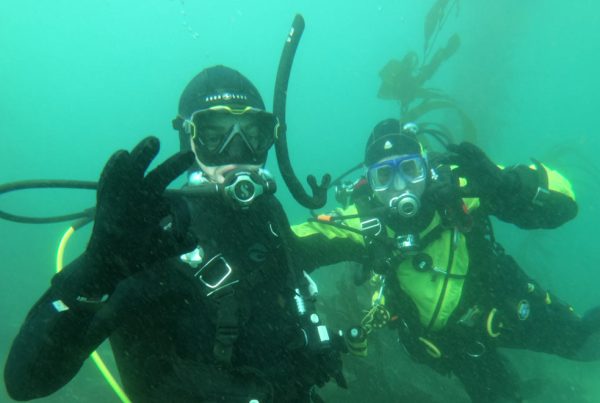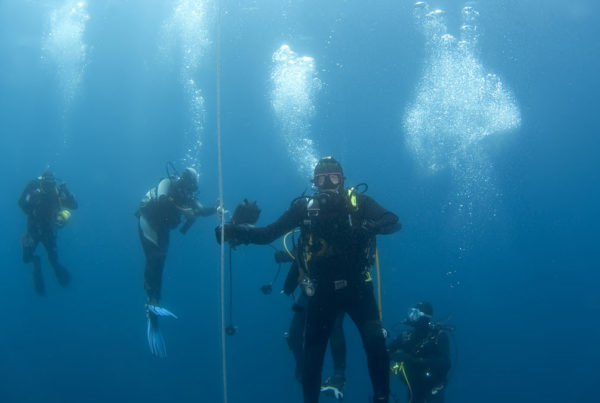WATER ENTRY AND EXIT
At water’s edge take a moment to again study and time the wave sets. Using the timing you gathered observing before dressing in, you will be timing your passage through the surf zone. Now is the key time to decide on a go or no-go. Remember, nobody ever got hurt from a dive they did not make (Ken Kurtis, circ. 1993). Ask yourself: Can I handle the largest wave I have observed to this point? While in theory, with proper timing, you will avoid the larger waves, you always need to be at peace with the fact that you could miss-time your entry and exit and have to deal with the largest wave this beach has to dish up at this time. Time the sets again. Put on your mask and fins and with your regulator in hand, and BC slightly filled, wait for a set of large waves to pass and go on the lull between the sets. On the lull, with regulator in and fins on—go. Get through the surf zone as quickly as possible, then resting just beyond where the waves are breaking. This point cannot be emphasized enough—get through the surf zone as quickly as possible. Do not linger in the surf zone. If you have a problem, get out of the water or get beyond the surf zone.
Wearing fins through the surf zone is critical. Without fins you have little propulsion, and if you get knocked down, limited ability to move. Only go in and out with fins in hand (straps over wrists) if the surf is small—one foot or less.
As you move into the water, do not shuffle backwards. Never, ever turn your back on the ocean. Obviously you can’t go in straight ahead with fins on—but rather side shuffle. This not only puts you in a good position for vision, this is the best way to take a wave by bracing your shoreward leg and leaning your shoulder into medium-sized waves.
As soon as you’re in thigh-deep water, perhaps less, turn over face down and swim. You’ll have more control of your situation with the ability to dive under waves. Do not fight the force of the waves rather use them to your advantage. Wave force moves in two directions on the beach, up and back. As the wave pushes up the beach, kick gently to hold your position. As the water recedes, flowing back out to sea, go with the flow. As a wave heads in your direction, go under it. Most of the force of a wave is on top.
One more important point: Whenever you take a wave, or in the maelstrom of a wave, put one hand over your mask and regulator at the same time so they will not become dislodged. Use the other hand, either on your BC inflator or hanging on to other dive gear (cameras, lights, buoy line, etc.). If using a buoy, tow it behind you on the way out and push it in front of you on the way in.
Exiting the water can just as easy as entry. Just offshore of the surf zone, stop to rest and again time the sets. Regulator in mouth, BCD slightly inflated so you are a bit buoyant, time the lull between the waves and go, as fast as you can safely proceed.
When you get to waist-deep water, and if the surf is small,
you can remove your fins, looping the straps over your wrists, because if you don’t and you stumble, you will likely lose your expensive diving footwear.
BUDDY SYSTEM IN THE SURF ZONE
The buddy system takes on a whole different look in the surf zone. Help each other get fins on, do your full buddy check, but DO NOT hang on to each other through the surf zone. If you hang on to each other, and one falls, both will go down and chaos will ensue. Also, there is a greater chance of both buddies getting into trouble at the same time—trouble doubled. Each member of the buddy team should go through the surf zone separately. As one passes through, the other stays on the beach ready to go, fully dressed in, watching. Should the first get in trouble, the one on the beach can drop their heavy gear (tank assembly and weights) and swim out to assist the buddy in trouble.
Once the buddy is safely through the surf zone, and rested, the second member of the buddy team will cross the zone (after timing the waves sets, of course). Should the second member of the buddy team get in serious trouble in the surf zone, the one offshore can then drop and or float their heavy gear there before moving in for the rescue. Water exit for a buddy team works the same, only in reverse.
POST DIVE
A comfortable, enjoyable beach dive often lies in the pacing. Take our time at every step, even after exiting the water and making your way back to your car. There is no reason to hurry. If there is shower available, rinse liberally to minimize the salt, sand and other gick in your vehicle. If there is no shower, keep a good size jug of freshwater both for rinsing and re-hydration. And you will need to re-hydrate liberally. You might want to have a healthy snack handy for blood sugar replenishment, particularly if you plan a second dive.
Stomp your feet and brush off as much sand as possible. A tarp or some other kind of ground cover can be handy at your vehicle but remove your gear first before stepping on the tarp for a final cleanup. In your vehicle a large tub is best to store your wet, sandy, salty gear. You can then rinse and dry your body before getting in your vehicle to buzz home with your tales of underwater adventures.










